Christian Democratic Appeal
The Christian Democratic Appeal (Dutch: Christen-Democratisch Appèl, pronounced [krɪstə(n)deːmoːkraːtis ɑˈpɛl]; CDA) is a Christian-democratic[11][12][13] political party in the Netherlands. The CDA was originally formed in 1977 from a confederation of the Catholic People's Party, the Anti-Revolutionary Party and the Christian Historical Union,[13] since becoming a unitary party, and has participated in all but three Dutch governments since then. Hugo de Jonge has been the Leader of the Christian Democratic Appeal since 15 July 2020.
Christian Democratic Appeal Christen-Democratisch Appèl | |
|---|---|
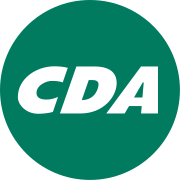 | |
| Abbreviation | CDA |
| Leader | Hugo de Jonge |
| Chairman | Rutger Ploum |
| Honorary chairman | Piet Steenkamp |
| Leader in the Senate | Ben Knapen |
| Leader in the House of Representatives | Pieter Heerma |
| Leader in the European Parliament | Esther de Lange |
| Founded | 23 June 1973 (alliance) 11 October 1980 (party) |
| Merger of | Catholic People's Party Anti-Revolutionary Party Christian Historical Union |
| Headquarters | Partijbureau CDA Buitenom 18 The Hague |
| Youth wing | Christian Democratic Youth Appeal |
| Think tank | Wetenschappelijk bureau CDA |
| Membership (2020) | |
| Ideology | Christian democracy[2] Social conservatism[3][4] |
| Political position | Centre[5][6][7] to centre‑right[8][9][10][11] |
| European affiliation | European People's Party |
| International affiliation | Centrist Democrat International |
| European Parliament group | European People's Party |
| Colours | Green |
| Seats in the House of Representatives | 19 / 150 |
| Seats in the Senate | 9 / 75 |
| Seats in the States-Provincial | 73 / 570 |
| Seats in the European Parliament | 4 / 29 |
| King's Commissioners | 5 / 12 |
| Website | |
| www.cda.nl | |
| |
Following the 2017 general election, where the party won 19 seats (third place), the CDA has been a junior coalition partner in the Third Rutte cabinet with the People's Party for Freedom and Democracy, Democrats 66 and Christian Union.
History
History before 1977
Since 1880 the sizeable Catholic and Protestant parties had worked together in the so-called Coalitie. They shared a common interest in public funding of religious schools. In 1888 they formed the first Christian-democratic government, led by the Anti-Revolutionary Æneas Baron Mackay. The cooperation was not without problems and in 1894 the more anti-papist and aristocratic conservatives left the Protestant Anti-Revolutionary Party, to found the Christian Historical Union (CHU). The main issues dividing Protestants and Catholics was the position of the Dutch Representation at the Holy See and the future of the Dutch Indies.
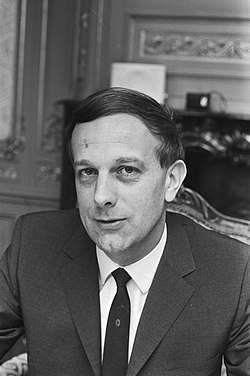
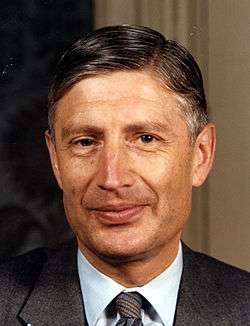
By 1918, there were three major Christian Democratic parties in the Netherlands—the General League of Roman Catholic Caucuses, the Protestant Anti-Revolutionary Party and the Protestant Christian Historical Union. The General League evolved into the Roman Catholic State Party by 1926, and the Catholic People's Party in 1945.
From 1918 to 1967, the three Christian Democratic parties had a majority in both houses of the States General, and at least two of them were included in every cabinet. The KVP and its antecedents had been in government without interruption since 1918.
In the sixties, Dutch society became more secularised and the pillars faded, and voters began to move away from the three Christian-democratic parties. In the 1963 general election the three parties held 51% of the vote, whilst in 1972 general election they held only 32%. This decline forced the three parties to work closer together. In 1967 the Group of Eighteen was formed: it was a think-tank of six prominent politicians per party that planned the future cooperation of the three parties. In 1968 the three political leaders of the parties (Norbert Schmelzer (KVP), Barend Biesheuvel (ARP) and Jur Mellema (CHU) made a public appearance, stating that the three parties would continue to work together.
This caused progressive forces within the three parties, especially the ARP and KVP, to regret their political affiliation. In 1968 they founded the Political Party of Radicals (PPR), a left-wing party that sought cooperation with the Labour Party (PvdA). Locally and provincially however the three parties had long cooperated well, in some areas they formed one Christian-democratic parliamentary party and proposed one list of candidates. In the 1971 general election, the three parties presented a common political program, which lay the foundation for the first Biesheuvel cabinet.
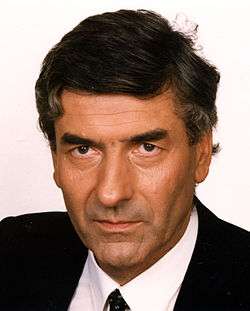
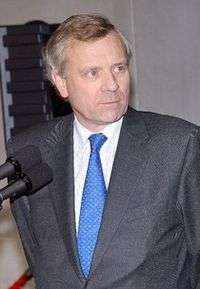
After the disastrous elections of 1972 the cooperation was given new momentum. Piet Steenkamp, a member of the Senate for the KVP was appointed chairman of a council which was to lay the foundation for a federation of the three parties, and provide a common manifesto of principles. In 1973 this federation was officially formed, with Steenkamp as chairperson.
The cooperation was frustrated by the formation of the Den Uyl cabinet, established by the leader of the social-democratic PvdA and Prime Minister of the Netherlands Joop den Uyl. Den Uyl refused to allow members of the CHU in the cabinet that he would lead. This led to a situation where the CHU, ARP and KVP sat as a single faction in both houses of parliament, but only the KVP and ARP supplied ministers and junior ministers. The cabinet Den Uyl was riddled with political and personal conflicts. Another issue that split the three parties was the place that the Bible would take in the new party.
Period of CDA prime ministers 1977–1994
In 1976, the three parties announced that they would field a single list at the 1977 general election under the name Christian Democratic Appeal (Christen Democratisch Appèl). The KVP minister of Justice, Dries van Agt, was the top candidate. In the election campaign he made clear the CDA was a centrist party, that would not lean to the left or to the right. The three parties were able to stabilise their proportion of the vote.
The election result forced Van Agt to start talks with Den Uyl. Although Van Agt had been Deputy Prime Minister in the cabinet Den Uyl, the two had never gotten along well. The animosity between them frustrated the talks. After more than 300 days of negotiations, they finally officially failed, and Van Agt was able to negotiate a cabinet with the conservative-liberal People's Party for Freedom and Democracy (VVD). The first Van Agt cabinet had a very narrow majority. The unexpected cabinet with the VVD led to split within the newly founded CDA between more progressive and more conservative members. The progressives remained within the party, and were known as loyalists. On 11 October 1980, the three original parties ceased to exist and the CDA was founded as a unitary party. After the 1981 general election, the VVD and the CDA lost their majority, and the CDA was forced to cooperate with the PvdA. Den Uyl became deputy prime minister under van Agt. The second Van Agt cabinet was troubled by ideological and personal conflicts, and fell after one year.
After the 1982 general election, the new CDA leader, Ruud Lubbers (formerly of the KVP), formed a majority coalition with the VVD. The first Lubbers cabinet set an ambitious reform program in motion, which included budget cuts, reform of the old age and disability pensions and liberalisation of public services. Lubbers was reelected in 1986 and in 1989. In 1989 however, the CDA only garnered a minimal majority with the VVD, which they had also gradually fallen out with during the previous cabinet, leading the CDA to instead cooperate with the PvdA in the new government. In the third Lubbers cabinet, a CDA-PvdA coalition, the ambitious reform project was continued, with some adaptations and protests from the PvdA.
1994–2002
The 1994 general election was fraught with problems for the CDA: personal conflicts between retiring prime minister Lubbers and lijsttrekker Elco Brinkman, a lack of support for the reforms of old age and disability pensions, and the perceived arrogance of the CDA caused a dramatic defeat at the polls. A new coalition was formed between PvdA and the liberal parties VVD and Democrats 66 (D66), consigning the CDA to opposition for the first time ever. It was also the first government without any Christian Democratic ministers since 1918. The party was marred by subsequent internal battles over leadership. The party also reflected on its principals: the party began to orient itself more toward communitarian ideals.
Balkenende cabinets, 2002–2010
During the tumultuous 2002 general election, which saw the murder of far-right politician Pim Fortuyn, many people voted for the CDA, hoping that it could bring some stability to Dutch politics. The CDA led the first Balkenende cabinet, which included the VVD and the Pim Fortuyn List (LPF). This cabinet fell due to internal struggles within the LPF. After the 2003 general election, the Christian Democrats were forced to begin cabinet negotiations with the PvdA. Personal animosity between Balkenende and the leader of the PvdA, Wouter Bos, frustrated these negotiations. Balkenende eventually formed a coalition with the VVD and D66. The coalition proposed an ambitious program of reforms, including more restrictive immigration laws, democratisation of political institutions and reforms of the system of social security and labour laws.
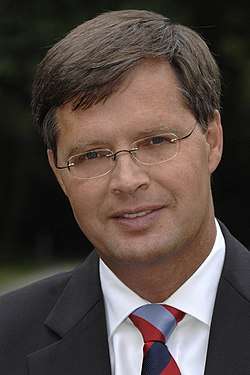

After the 2006 general election the CDA changed their course radically: they formed a new fourth cabinet Balkenende still led by Balkenende, but now with the PvdA and the Christian Union (CU). The cabinet was more progressive, entailing increased government spending funded by higher taxes.[14]
Partner in Rutte cabinets, 2010–present
In the 2010 general election the CDA lost half of its seats and came in fourth place after VVD, PvdA and the Party for Freedom (PVV). Balkenende announced his resignation and stayed prime minister until the formation and inauguration of the Rutte cabinet.
After the fall of the short-lived first Rutte cabinet in 2012, in which the CDA participated as junior coalition partners to the VVD, the party announced a leadership election. On 18 May 2012 the party announced that the leadership elections were won by Sybrand van Haersma Buma. He received more than 50 percent of the votes. The popular Mona Keijzer, the rising star within the party, received 26% of the votes and announced that she would closely collaborate with Van Haersma Buma during the election campaign prior to the Dutch general election on 12 September 2012. In that election, the CDA suffered considerable losses, falling to 13 seats. The party was excluded from the second Rutte cabinet—only the second time in its history that the party has not been in government. At the municipal elections of 19 March 2014 the CDA won 18% of all the votes and remained the largest party in Dutch municipalities.[15]
In the 2017 general elections, the CDA gained six seats to become the third largest party.[16] It continued to remain in government as part of the third Rutte cabinet, with the VVD, D66 and CU.
Ideology
The CDA is a Christian democratic party, but Christian values are only seen as one source of inspiration for individual members of parliament. The party also has Jewish, Muslim and Hindu members of parliament and favours the integration of minorities into Dutch culture.
The party has four main ideals: stewardship, shared responsibility, public justice, and solidarity. Shared responsibility refers to the way society should be organised: not one organisation should control all society, instead the state, the market, and social institutions, like churches and unions should work together. This is called sphere sovereignty, a core concept of Neo-Calvinist political philosophy. Furthermore, this refers to the way the state should be organised. Not one level of the state should have total control; instead, responsibility should be shared between local, provincial, national and European governments. This is called subsidiarity in Catholic political thought. With stewardship the Christian Democrats refer to the way the planet ought to be treated: the Earth is a gift from God. Therefore, we should try to preserve our environment.[17]
Practically, this means the CDA is a centre party. However, the party has a considerable centre-left wing, that supports eco-friendly politics, a strong pro-European policy and favours centre-left coalitions. The position of the centre-left group within the party has been weakened since the party's participation in the centre-right minority cabinet with the VVD (the first Rutte cabinet), a cabinet that strongly depended on the parliamentary support of the far-right Party for Freedom (PVV). CDA politicians that can be considered centrist or centre-left: Jack Biskop (MP), Ad Koppejan (MP), Kathleen Ferrier (MP; daughter of the late Johan Ferrier, president of Suriname 1975–1980), Dries van Agt (former Prime Minister), Ruud Lubbers (former Prime Minister) and Herman Wijffels (former chairman of the Social Economic Council, former informateur).
In the past Maxime Verhagen, then informal leader of the CDA and deputy Prime Minister, strongly denied the claim that the CDA is a right-wing party. Verhagen made it clear to the media that his party is a centrist and moderate party and that the CDA participates in a centre-right coalition (with the People's Party for Freedom and Democracy (VVD) as the right-wing component and the CDA as the centrist component).[18] However, his former colleague in the cabinet, minister of Defence Hans Hillen, was a strong proponent of a conservative CDA.
- The state deficit should be repaid in one generation to cope with the effects of the aging population.
- The toleration of soft drugs should come to an end and the practices of prostitution, abortion and euthanasia should be more limited.
- The party is a staunch proponent of European integration and Turkey's possible EU membership in the future.
- The party wants to make schools and hospitals more responsible for their own policy instead of being regulated by the government.
New party course
At a congress on 21 January 2012 the party adopted a centrist course, dubbed by former minister of Social Affairs Aart-Jan de Geus as "Radical centrist" ("het radicale midden").[19] The party explicitly abandoned its former center-right course. Despite of this, the party continued its coalition with the centre-right VVD of Prime Minister Mark Rutte and the Party for Freedom of Geert Wilders until the government collapsed later in the year.
The so-called Strategic Council, which was formed in 2011 and headed by former minister Aart-Jan de Geus, that worked on a report to redifine the party course, advised the following:
- limiting the so-called Home mortgage interest deduction;
- introduction of flat tax;
- eco-friendly policy (ecotax);
- a pro-European policy;
- a more friendly immigration policy;
- equal chances for every person;
- more investment in higher education;
- and a modern social policy.
In 2014 party leader Van Haersma Buma announced that the party is now officially in favour of an elected mayor,[20] although a large majority of its party members are opposed to an elected mayor.[21]
Electoral results
.jpg)
.jpg)

House of Representatives
| Election | Lijsttrekker | Votes | % | Seats | +/– | Government |
|---|---|---|---|---|---|---|
| 1977 | Dries van Agt | 2,653,416 | 31.9 (#2) | 49 / 150 |
Coalition | |
| 1981 | 2,677,259 | 30.8 (#1) | 48 / 150 |
Coalition | ||
| 1982 | 2,420,441 | 29.4 (#2) | 45 / 150 |
Coalition | ||
| 1986 | Ruud Lubbers | 3,172,918 | 34.6 (#1) | 54 / 150 |
Coalition | |
| 1989 | 3,140,502 | 35.3 (#1) | 54 / 150 |
Coalition | ||
| 1994 | Elco Brinkman | 1,996,418 | 22.2 (#2) | 34 / 150 |
Opposition | |
| 1998 | Jaap de Hoop Scheffer | 1,581,053 | 18.4 (#3) | 29 / 150 |
Opposition | |
| 2002 | Jan Peter Balkenende | 2,653,723 | 27.9 (#1) | 43 / 150 |
Coalition | |
| 2003 | 2,763,480 | 28.6 (#1) | 44 / 150 |
Coalition | ||
| 2006 | 2,608,573 | 26.5 (#1) | 41 / 150 |
Coalition | ||
| 2010 | 1,281,886 | 13.6 (#4) | 21 / 150 |
Coalition | ||
| 2012 | Sybrand Buma | 801,620 | 8.5 (#5) | 13 / 150 |
Opposition | |
| 2017 | 1,301,796 | 12.4 (#3) | 19 / 150 |
Coalition |
Senate
| Election | Votes | Weight | % | Seats | +/– |
|---|---|---|---|---|---|
| 1991 | 27 / 75 |
||||
| 1995 | 19 / 75 |
||||
| 1999 | 20 / 75 |
||||
| 2003 | 46,848 | 29.0 (#1) | 23 / 75 |
||
| 2007 | 43,501 | 26.7 (#1) | 21 / 75 |
||
| 2011 | 86 | 24,260 | 14.6 (#3) | 11 / 75 |
|
| 2015 | 89 | 25,145 | 14.9 (#2) | 12 / 75 |
|
| 2019 | 76 | 19,756 | 11.4 (#3) | 9 / 75 |
European Parliament
| Election | List | Votes | % | Seats | +/– | Notes |
|---|---|---|---|---|---|---|
| 1979 | List | 2,017,743 | 35.60 (#1) | 10 / 25 |
new | [22] |
| 1984 | List | 1,590,218 | 30.02 (#2) | 8 / 25 |
2 |
[23] |
| 1989 | List | 1,813,035 | 34.60 (#1) | 10 / 25 |
2 |
[24] |
| 1994 | List | 1,271,840 | 30.77 (#1) | 10 / 31 |
0 |
[25] |
| 1999 | List | 951,898 | 26.94 (#1) | 9 / 31 |
1 |
[26] |
| 2004 | List | 1,164,431 | 24.43 (#1) | 7 / 27 |
2 |
[27] |
| 2009 | List | 913,233 | 20.05 (#1) | 5 / 25 |
2 |
[28] |
| 2014 | List | 721,766 | 15.18 (#2) | 5 / 26 |
0 |
[29] |
| 2019 | List | 669,555 | 12.18 (#3) | 4 / 26 |
1 |
[30] |
Representation
Members of the House of Representatives
Current members
Current members of the House of Representatives since the general election of 2017:
|
|
Seats
Seats in the House of Representatives:
Members of the Senate
Current members
Current members of the Senate since the election of 2019:
|
|
Seats
Seats in the Senate:
|
|
Members of the European Parliament
Current members
Current members of the European Parliament since the European Parliamentary election of 2019:
4 Seats:
| Part of a series on |
| Christian democracy |
|---|
 |
|
Ideas
|
|
The CDA has been a member of the European People's Party (EPP) since its founding in 1976,[31] and CDA MEPs sit in the EPP Group.
Local and provincial government
By far, the CDA has the most members of municipal and provincial councils in the Netherlands. Furthermore, it cooperates in most municipal and provincial governments.
Electorate
The CDA is mainly supported by religious voters, both Catholics and Protestants. These tend to live in rural areas and tend to be elderly. In some periods, however, the CDA has functioned as a centrist party, attracting people from all classes and religions.
Geographically, the CDA is particularly strong in the provinces of North Brabant, Limburg and Overijssel and in the Veluwe and the Westland areas. In the 2006 elections the CDA received the highest percentage of votes in the municipality of Tubbergen, Overijssel (66,59% of the vote). The CDA is weaker in the four major cities (Amsterdam, Rotterdam, The Hague and Utrecht) and in Groningen and Drenthe.
Organisation
Leadership
|
|
|
|
Linked organisations
The youth movement of the CDA is the Christian Democratic Youth Appeal (CDJA). The CDA publishes a monthly magazine, and its scientific bureau publishes the Christian Democratic Explorations (Christen-Democratische Verkenningen).
As an effect of pillarisation, the CDA still has many personal and ideological ties with religious organisations, such as the broadcasting societies KRO and NCRV, the paper Trouw, the employers organisations NCW and the union CNV.
The CDA participates in the Netherlands Institute for Multiparty Democracy, a democracy assistance organisation of seven Dutch political parties.
International organisations
The CDA is a member of the European People’s Party[37] and the Centrist Democrat International.[38] Within the EPP the CDA belongs to those parties which least favour a cooperation with conservatives.
International comparison
As a large Christian democratic party, the CDA is comparable to other European Christian democratic parties such as Germany's Christian Democratic Union (although it's more moderate). It is the Netherlands' third largest party (after the VVD and the PVV), but it is centrist unlike the British Conservative Party.
See also
- Abraham Kuyper
- List of Christian Democratic Appeal candidates for the Dutch general election, 2012
Further reading
- Bosmans, Jac (2004). Michael Gehler; Wolfram Kaiser (eds.). The Primacy of Domestic Politics: Christian Democracy in the Netherlands. Christian Democracy in Europe since 1945. Routledge. pp. 47–58. ISBN 0-7146-5662-3.
- Lucardie, Paul (2004). Steven Van Hecke; Emmanuel Gerard (eds.). Paradise Lost, Paradise Regained? Christian Democracy in the Netherlands. Christian Democratic Parties in Europe Since the End of the Cold War. Leuven University Press. pp. 159–177. ISBN 90-5867-377-4.
References
- "Forum voor Democratie qua ledental de grootste partij van Nederland" (PDF). Documentatiecentrum Nederlandse Politieke Partijen (in Dutch). Retrieved 27 January 2020.
- Nordsieck, Wolfram (2017). "Netherlands". Parties and Elections in Europe. Retrieved 4 August 2018.
- Paul Lucardie; Hans-Martien Tennapel (1996). "Between Confessionalism and Liberal-Conservatism: the Christian Democratic Parties of Belgium and the Netherlands". In David Hanley (ed.). Christian Democracy in Europe. A&C Black. p. 64. ISBN 978-1-85567-382-3.
- Paul Lucardie (2004). "Paradise Lost, Paradise Regained? Christian Democracy in the Netherlands". In Steven Van Hecke; Emmanuel Gerard (eds.). Christian Democratic Parties in Europe Since the End of the Cold War. Leuven University Press. pp. 169–170. ISBN 978-90-5867-377-0.
- "Netherlands". Freedom in the World 2003. Freedom House. Archived from the original on 29 June 2019. Retrieved 29 June 2019.
- Bremmer, Ian (13 September 2012). "Going Dutch: The Netherlands' election results roll in". Foreign Policy. Retrieved 29 June 2019.
- Delcker, Janosch (18 February 2018). "Risk of bioweapon attack growing, Dutch defense minister says". POLITICO. Munich. Retrieved 5 May 2020.
Bijlevel, a member of the centrist Christian Democratic Appeal party, said that the technology for creating biological weapons had advanced dramatically in recent years, while at the same time “the international community continues to underestimate this risk.”
- Weaver, Matthew (16 March 2017). "Dutch elections: Rutte starts coalition talks after beating Wilders into second – as it happened". The Guardian. Retrieved 30 March 2019.
- Syuzanna Vasilyan (2009). "The integration crisis in the Netherlands: the causes and the new policy measures". In Ditta Dolejšiová; Miguel Angel García López (eds.). European Citizenship in the Process of Construction: Challenges for Citizenship, Citizenship Education and Democratic Practice in Europe. Council of Europe. p. 73. ISBN 978-92-871-6478-0.
- Hans Vollaard; Gerrit Voerman; Nelleke van de Walle (2015). "The Netherlands". In Donatella M. Viola (ed.). Routledge Handbook of European Elections. Routledge. p. 171. ISBN 978-1-317-50363-7.
- Kees Van Kerbergen; André Krouwel (2013). "A double-edged sword! The Dutch centre-right and the 'foreigners issue'". In Tim Bale (ed.). Immigration and Integration Policy in Europe: Why Politics – and the Centre-Right – Matter. Routledge. pp. 91–92. ISBN 978-1-317-96827-6.
- Wijbrandt H. Van Schuur; Gerrit Voerman (2010). "Democracy in Retreat? Decline in political party membership: the case of the Netherlands". In Barbara Wejnert (ed.). Democratic Paths and Trends. Emerald Group Publishing. p. 28. ISBN 978-0-85724-091-0. Retrieved 20 August 2012.
- Christopher Anderson (1995). Blaming the Government: Citizens and the Economy in Five European Democracies. M.E. Sharpe. p. 64. ISBN 978-1-56324-448-3. Retrieved 21 August 2012.
- "Google Groups".
- "CDA grootste na 80 procent stemmen geteld".
- Kiesraad (21 March 2017). "Kerngegevens Tweede Kamerverkiezing 2017 - Rapport - Kiesraad.nl". www.kiesraad.nl.
- "Uitgangspunten". CDA (in Dutch). Retrieved 7 March 2018.
- "Archived copy". Archived from the original on 28 December 2010. Retrieved 31 July 2011.CS1 maint: archived copy as title (link)
- "'CDA moet kiezer weer raken met keuze voor radicale midden'".
- "CDA voor gekozen burgemeester".
- "Veel steun gekozen burgemeester".
- "Kiesraad: Europees Parlement 7 juni 1979" (in Dutch). Kiesraad. Retrieved 19 June 2019.
- "Kiesraad: Europees Parlement 14 juni 1984" (in Dutch). Kiesraad. Retrieved 19 June 2019.
- "Kiesraad: Europees Parlement 15 juni 1989" (in Dutch). Kiesraad. Retrieved 19 June 2019.
- "Kiesraad: Europees Parlement 9 juni 1994" (in Dutch). Kiesraad. Retrieved 19 June 2019.
- "Kiesraad: Europees Parlement 10 juni 1999" (in Dutch). Kiesraad. Retrieved 19 June 2019.
- "Kiesraad: Europees Parlement 10 juni 2004" (in Dutch). Kiesraad. Retrieved 19 June 2019.
- "Kiesraad: Europees Parlement 4 juni 2009" (in Dutch). Kiesraad. Retrieved 19 June 2019.
- "Kiesraad: Europees Parlement 22 mei 2014" (in Dutch). Kiesraad. Retrieved 19 June 2019.
- "Kiesraad: Europees Parlement 23 mei 2019" (in Dutch). Kiesraad. 4 June 2019. Retrieved 19 June 2019.
- Thomas Jansen; Steven Van Hecke (2011). At Europe's Service: The Origins and Evolution of the European People's Party. Springer. p. 51. ISBN 978-3-642-19413-9.
- "Christen-Democratisch Appèl (CDA)". Parlement & Politiek (in Dutch). Retrieved 7 March 2018.
- "Partijvoorzitters CDA". Parlement & Politiek (in Dutch). Retrieved 7 March 2018.
- "Eerste Kamerfractie Christen-Democratisch Appèl (CDA)". Parlement & Politiek (in Dutch). Retrieved 7 March 2018.
- "Tweede Kamerfractie Christen Democratisch Appel (CDA)". Parlement & Politiek (in Dutch). Retrieved 7 March 2018.
- "Lijsttrekkers CDA". Parlement & Politiek (in Dutch). Retrieved 7 March 2018.
- "Parties". Archived from the original on 27 March 2012. Retrieved 6 June 2012.